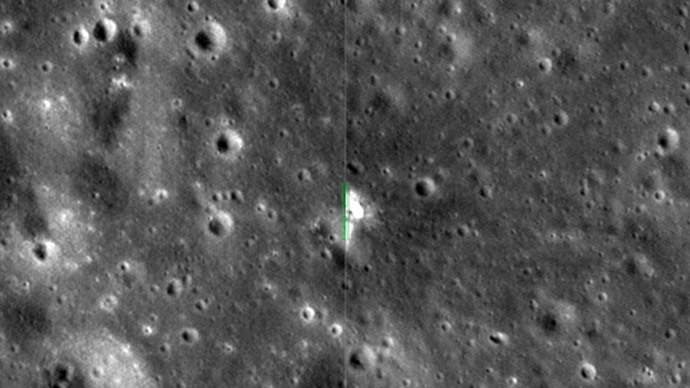NASA orbiter records new crater on the Moon (VIDEO)

NASA’s Lunar Reconnaissance Orbiter has revealed images of the lunar surface before and after the largest recorded explosion detected on the surface. The luminous flash was recorded by researchers at NASA’s Marshall Space Flight Center in Huntsville.
An object the size of a small boulder hit the surface in Mare
Imbrium two years ago, and exploded in a flash of light
"nearly 10 times as bright as anything ever recorded
before," NASA said. Since 2005 the Marshall group recorded
over 300 flashes, assumed to be meteoroid impacts. The brightest
recorded flash occurred on March 17, 2013.
The Lunar Reconnaissance Camera (LROC) scientists managed to
obtain observations before and after the impact. The US space
agency explained in a statement that comparing the actual size of
the crater to the brightness of the flash helps to validate
impact models.
LROC’s first set of post-impact flash images, which were acquired in May 2013 by the Narrow Angle Camera (NAC), were targeted on the Marshall-reported coordinates. Numerous small surface disturbances (described as “splotches” by Nasa) were detected by comparing the pre- and post-flash images. No new crater was found, however.
A second set of NAC images was obtained later that year in July, featuring three "faint ray-like features and several chains of splotches and asymmetric splotches" that pointed to a common area west of the Marshall coordinates. A NAC pair was targeted on that convergence point for July 28, 2013. In the long run, comparison of this third set of images with pre-existing coverage finally revealed a new crater.
READ MORE: New views of dwarf planet Ceres released by NASA
The crater itself appears to be small, measuring 18.8 meters in
diameter, but its influence is large, according to Nasa, with
debris excavated by the sudden release of energy flown for
hundreds of meters. Over 200 related surficial changes up to 30
kilometers away were noted.
The LROC team is now busy studying images taken in the first year
or two and comparing them to recent images. Called temporal
pairs, these before/after images help reveal various surface
changes.
Since its launch in 2009, LRO has collected a treasure trove of
indispensable data, expanding the horizons of our knowledge about
the Moon.












